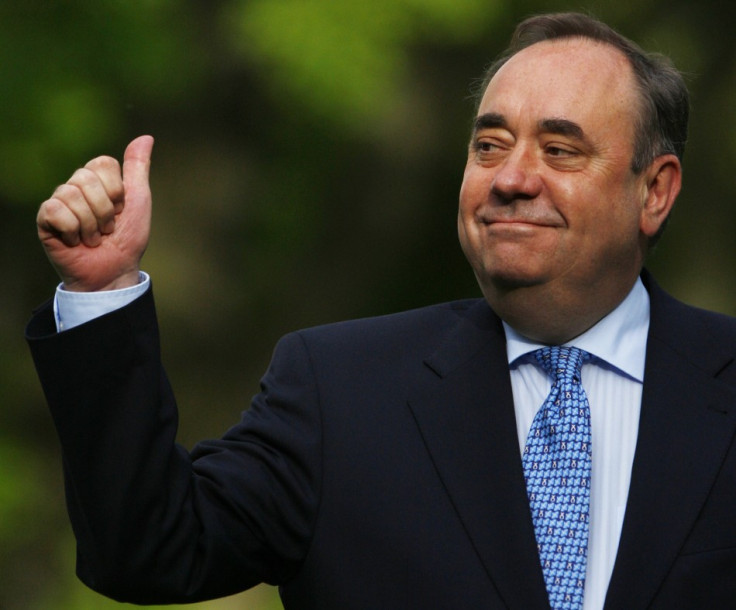Scottish elections: The "Fringe" comes early to Edinburgh but any "Festival" is the SNP's

Nominations for the election of a new Scottish Liberal Democrat leader close today, Tuesday,17 May 2011 at midday. This follows the resignation of Tavish Scott, MSP for the Shetland Isles after the Lib Dem's disastrous 05 May 2011 Election results for the Scottish Parliament reduced their membership to five.
Iain Gray, the leader of the Labour Party in the Scottish Parliament since September 2008, announced on 06 May 2011 that he will be stepping down in the autumn after just retaining his East Lothian seat with a majority of 151 over the SNP candidate. Mr Gray saw many of his close colleagues lose their seats - all to the SNP - and for Labour in Scotland, the election results were astonishing and historic - an historic defeat and failure.
Leader of the Scottish Conservatives, Annabel Goldie, was the third opposition party leader to announce on Monday 09 May 2011 that she too would be quitting the head post in the autumn. Although many of her political opponents concede she fought a robust and worthy election campaign, Miss Goldie told the media that she was "disappointed" by the party's performance at the polls. Miss Goldie insisted that she retained Prime Minister, David Cameron's full support and that rumours of a forced resignation were "absolutely incorrect".
What a difference an election makes!
There should have been a warning on TV screens on the morning of 06 November 2011 to the effect that no adjustment to the picture was necessary. Yes, the figures emerging from constituency after constituency were true. With an average 12.5 per cent gain in the constituency vote for the Scottish National Party (SNP) and a total poll of just under 903,000 to Labour's 639,461, the First-past-the-post element in the 05 May 2011 Election for the Scottish Parliament at Holyrood gave the SNP an incredible 53 of the 73 constituency seats.
The Scottish Labour Party came second with just 15; The Scottish Conservative Party won three; and the Scottish Liberal Democrats, two - the very small in population, Orkney Isles and Shetland Isles. The Opposition had been reduced to a fringe.
Under a First--past-the-post electoral system, Scotland would have become a one-party state - but not under the party all had formerly presumed, a Labour one.
To introduce some measure of balance and to avoid any single party becoming dominant, the Parliament at Holyrood is designed with an Additional Member System of proportional representation whereby 56 "List" seats are elected from Scotland's eight regions.
A person's List vote is for a party and on a separate ballot paper. Each of the parties submit a list of names of prospective MPs for each region. The higher up the list, the better chance of becoming a regional MP for that party. Prospective candidates can run for a constituency seat and also have their name on the regional List but should they be elected MP for the constituency, their name is removed from the List
Scotland's eight regions are Highlands and Islands, North-East, Mid-Scotland and Fife, Central, Glasgow, West, Lothians, and South and each region elects seven List members to the Parliament, roughly in proportion to the votes cast in that region but using a formula which puts the winning party in the Constituencies, at a disadvantage (the D'Hondt, largest remainder method of calculation).
No system is always perfect and this certainly proved to be the case as the counting proceeded after the polling stations had closed on 05 May 2011. Once the Regional votes were counted, it was found that the SNP had won 44 per cent, slightly below their constituency vote tally and really exceptional in a multi-party contest.
The range of the Regional/List vote, varied between 39 per cent in Glasgow and Lothian Regions to 53 per cent in North-East Region and was so marked that the SNP's 16 List MPs easily put them in an overall majority with 69 out of 129 Scottish Parliament MPs. No fewer than 25 Lib Dems lost their deposits - polling less than five per cent of the constituency vote - making the proportional voting element work not quite as well as intended. .
Only a couple of months before the Election such a result would have been laughed at as the opinion polls indicated that the Scottish Labour Party had a commanding lead of 15 per cent. Its leader, Iain Gray, would be duly elected the next First Minister and Labour would once more assume its traditional dominance in Scottish politics - the 2007 Election had been just a blip.
Labour had some good campaign policies - compulsory jail sentences for knife crimes and cutting cancer waiting times being both popular and do-able. Other policies in the current economic climate were more wishful thinking.
The rot for Labour set in when Mr Gray: trying to avoid protesters whilst doing a promotional shoot in central Glasgow; hid from them in a Subway outlet, only for the protesters to pursue him and force a confrontation in front of the TV cameras. After that it was pretty much all downhill.
As the gap in the opinion polls closed between Labour and the SNP they were seen to adopt SNP campaign policies - no university tuition fees for Scottish students and a freeze on the council tax. A case no doubt of imitation being the sincerest form of flattery!
A very real problem however, and noticed by the party's supporters, was that all too often Labour was attacking the Conservative/Lib Dem coalition at Westminster, to the exclusion of addressing Scottish matters. This was compounded after the SNP pulled ahead in the polls when many in Labour's ranks attacked Mr Salmond and then tried to frighten the voters with the spectre of Independence.
Independence had never been raised in the election campaign by any party until that time - about a fortnight before polling day - and impressed no-one. David Clegg, writing in the (Dundee) Courier on 07 May 2011 commented: "...Labour must also take responsibility for their defeat. Their election campaign was embarrassingly amateurish and at times simply patronised the intelligence of the public..."
Mr Clegg could have added that the Labour leadership took their support for granted. Labour's 'campaign' in some constituencies amounted to a leaflet through the letterbox, so sure were they of their "vote being weighed, not counted" in their traditional heartlands in central Scotland. Korky the Cat could stand as a Labour candidate and win an election.
A final humiliation came when many of their former senior MPs lost their seats. So sure was Labour of victory in the likes of the Clydeside constituencies that the Party failed to place these subsequent losers on the Regional List! Nearly all their List MPs are new and inexperienced in parliamentary politics and unknown outside their local Labour branch.
The SNP won because their campaign always emphasised the positive, was slick, professional, very competent - some said "ruthlessly" so - promoted a vision of and for Scotland that inspired the electorate and had attractive ideas, especially in the renewable energy fields? Yes, I can broadly agree with that. Worryingly for the opposition, the SNP's campaign attracted the young, including those at present too young to vote
Tom Peterkin in The Scotsman on 07 May 2011 described Mr Salmond and his SNP cohorts as "Slick, ruthless and unrelenting". Ewan Crawford in the same paper called the SNP's campaign "brilliant" and perfectly conducted". Mr Crawford went on to comment:
"...I now realise the SNP's essential offer was not contained in a six-week campaign slogan or sound bite but was, in fact, implicitly being made every day for four years just through the act of governing well
"If you prove to be a conscientious, caring and principled government, there's every chance voters will be minded to give you another shot.".
© Copyright IBTimes 2025. All rights reserved.





















